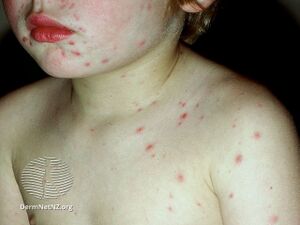Maculopapular rash
| Maculopapular rash | |
|---|---|
 | |
| The macular, papular, and finally vesicular rash of chickenpox | |
| Specialty | Dermatology |
A maculopapular rash is a term frequently used to describe a type of rash characterized by small bumps in association with small flat red spots on skin.[1]
It may only appear red in lighter-skinned people.
Differential diagnosis
This type of rash is common in several diseases and medical conditions, including scarlet fever, measles, Ebola virus disease, rubella, secondary syphilis (Congenital syphilis, which is asymptomatic, the newborn may present this type of rash), erythrovirus (parvovirus B19), chikungunya (alphavirus), zika, smallpox (which has been eradicated), varicella (when vaccinated persons exhibit symptoms from the modified form), heat rash, and sometimes in Dengue fever. It is also a common manifestation of a skin reaction to the antibiotic amoxicillin or chemotherapy drugs.[2] Skin infiltration of leukemic cells may also have this appearance. Maculopapular rash is seen in graft-versus-host disease (GVHD) developed after a hematopoietic stem cell transplant (bone marrow transplant), which can be seen within one week or several weeks after the transplant. In the case of GVHD, the maculopapular lesions may progress to a condition similar to toxic epidermal necrolysis.[3] In addition, this is the type of rash that some patients presenting with Ebola virus hemorrhagic (EBO-Z) fever will reveal but can be hard to see on dark skin people.[4] It is also seen in patients with Marburg hemorrhagic fever, a filovirus not unlike Ebola.
This type of rash can be as a result of large doses of niacin or no-flush niacin (2000 – 2500 mg),[citation needed] used for the management of low HDL cholesterol.[5]
This type of rash can also be a symptom of Sea bather's eruption. This stinging, pruritic, maculopapular rash affects swimmers in some Atlantic locales (e.g., Florida, Caribbean, Long Island). It is caused by hypersensitivity to stings from the larvae of the sea anemone (e.g., Edwardsiella lineate) or the thimble jellyfish (Linuche unguiculata). The rash appears where the bathing suit contacts the skin.[6]
This type of rash can also be a symptom of acute arsenic intoxication, appearing 2 weeks later.[7]
See also
References
- ↑ James, William D.; Elston, Dirk; Treat, James R.; Rosenbach, Misha A.; Neuhaus, Isaac (2020). "2. Cutaneous signs and diagnosis". Andrews' Diseases of the Skin: Clinical Dermatology (13th ed.). Elsevier. p. 11. ISBN 978-0-323-54753-6. Archived from the original on 2022-10-13. Retrieved 2022-12-05.
- ↑ "Managing allergic reactions to chemotherapy, chemocare.com". Archived from the original on 2012-08-17. Retrieved 2022-03-14.
- ↑ "Graft Versus Host Disease, emedicine.com". Archived from the original on 2017-08-09. Retrieved 2022-03-14.
- ↑ Stanford University 1997, Accessed Oct. 2014 https://web.stanford.edu/group/virus/filo/humandiseases.html Archived 2020-08-03 at the Wayback Machine
- ↑ McGovern ME (2005). "Taking aim at HDL-C. Raising levels to reduce cardiovascular risk". Postgrad Med. 117 (4): 29–30, 33–5, 39 passim. doi:10.3810/pgm.2005.04.1610. PMID 15842130.
- ↑ Overview of Marine Bites and Stings, by Robert A. Barish, MD, MBA, Thomas Arnold, MD Archived 2015-03-13 at the Wayback Machine, Merck Manual
- ↑ http://www.hc-sc.gc.ca/ewh-semt/alt_formats/hecs-sesc/pdf/pubs/water-eau/arsenic/arsenic-eng.pdf Archived 2022-01-20 at the Wayback Machine[bare URL PDF]
- Pages with script errors
- Webarchive template wayback links
- All articles with bare URLs for citations
- Articles with bare URLs for citations from March 2022
- Articles with invalid date parameter in template
- Articles with PDF format bare URLs for citations
- All articles with unsourced statements
- Articles with unsourced statements from July 2008
- Medical terminology
- Dermatologic terminology